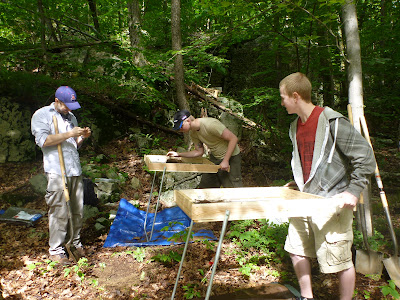I'm in the unusual situation of my kids being occupied and me having run out of small projects to complete around the house. So, I'll add another post in honor of the end of the 2012 season.
As we (who am I kidding? I didn't backfill, I made the students do it) backfilled the final excavation unit, it seemed appropriate to return something to the earth since we'd removed so many artifacts. I give you that dedication.
Friday, June 29, 2012
End of Field Season 2012
Yesterday, we finished up the first field season for the SUNY-Orange archaeological field school. The last day was full of last minute profiles (four of them, most with standing stone walls on top), photos and finally backfilling of the last feature. All in all, we excavated 49 shovel test pits and four excavation units. I now have an office full of artifacts to catalog, identify and analyze...which I am looking forward to.

I'm still largely in the dark about what exactly what was going on at the site, but we already know a lot more than we did a month ago. Once the artifact analysis really gets going, we will get a good sense of the when and what of the site.
The site did have a number of features visible on ground surface, but very few surface artifacts (one barrel ring). Prior to the field class, my doomsday scenario was that we would find no artifacts (a sure fire way to make students uninterested in archaeology). Fortunately, that was not the case. I haven't yet tallied, but my ballpark estimate is that we recovered somewhere around 300 artifacts. Almost every excavation unit was positive for artifacts. The bulk of the recovered artifacts were historic ceramics, glass and metal, though we do have at least one clear lithic flake (there's a few questionable that are awaiting a date with a toothbrush).
All in all, I'm very pleased with how things went for this inaugural year, and hope and intend to continue for many years to come.
I'd like to thank the Orange County Land Trust for their permission and enthusiastic support of the project. Their help is essential to this and future projects. Having a cooperating land owner/manager makes all the difference in the world. Of course, the project also wouldn't be anything without the students involved, so thanks (in no particular order) Brandon, Leah, Sean, Sean, Jordan, Daisy, Mike, Rich, and Joe.

I'm still largely in the dark about what exactly what was going on at the site, but we already know a lot more than we did a month ago. Once the artifact analysis really gets going, we will get a good sense of the when and what of the site.
The site did have a number of features visible on ground surface, but very few surface artifacts (one barrel ring). Prior to the field class, my doomsday scenario was that we would find no artifacts (a sure fire way to make students uninterested in archaeology). Fortunately, that was not the case. I haven't yet tallied, but my ballpark estimate is that we recovered somewhere around 300 artifacts. Almost every excavation unit was positive for artifacts. The bulk of the recovered artifacts were historic ceramics, glass and metal, though we do have at least one clear lithic flake (there's a few questionable that are awaiting a date with a toothbrush).
All in all, I'm very pleased with how things went for this inaugural year, and hope and intend to continue for many years to come.
I'd like to thank the Orange County Land Trust for their permission and enthusiastic support of the project. Their help is essential to this and future projects. Having a cooperating land owner/manager makes all the difference in the world. Of course, the project also wouldn't be anything without the students involved, so thanks (in no particular order) Brandon, Leah, Sean, Sean, Jordan, Daisy, Mike, Rich, and Joe.
Wednesday, June 13, 2012
Artifact Washing and Rapid Research
 |
| Washing Day |
 |
| Hard Rubber Button |
 |
| Bottle Neck |
 |
| Stone Floor of Feature where Bottle Uncovered |
 |
| Beautiful, Sunny Blue Skies |
Friday, June 8, 2012
Week 1
On Tuesday, we finally got going after our rain delay, so only a total of three days in the field. So far, we've completed all the shovel test pits of the smaller of two areas we'll be testing this season. Some artifacts have been recovered, but no unknown features were found. Next week, we'll begin excavating the two visible surface features.
Class on the first day, clean and awkwardly taken by surprise with unexpected photo.
First shovel test of the day. Here, I'm trying to impart good technique.
Examining first potential artifact of project
 |
| Feature 1 with surface accumulation cleared (twine borders funky due to lack of good spots for nails) |
First run through with screening.
Monday, June 4, 2012
Washout
The rain was falling as I was driving my kids to their daycare, but seemed to lighten up as I dropped them off. But, driving south correlated with increasing rain intensity...almost like the project site was a magnet for it.
All the students showed, or called, but the rain was just too much. The students and I held a quick meeting under the awning of a Rite Aid and then I drank too much coffee. Thankfully, the rain has continued since I made the weather cancellation call.
Here's hoping for better luck tomorrow.
Subscribe to:
Comments (Atom)






